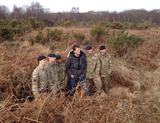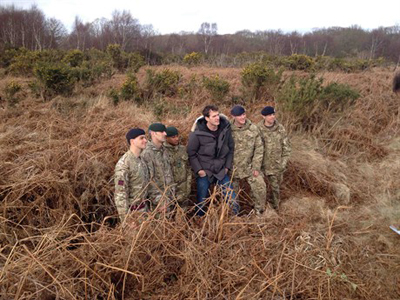Forgotten battlefield located in Hampshire
A practice battlefield from the First World War has been discovered in Hampshire


A forgotten‘practice' battlefield on which soldiers were drilled during the First World War before being sent to the trenches has been discovered by chance in Hampshire.
The heathland site in Gosport, which was overgrown and used as a picnic site, came to the attention of local council conservation officer Rob Harper a few months ago when he spotted what he recognised as trench systems in an aerial photograph. ‘I found myself walking along a ditch and realised it was part of an elaborate trench system, hidden for all these years by bracken and gorse. I looked around and there were trenches everywhere,' recalls Mr Harper.

Now, volunteers from the Armed Forces are working with English Heritage (EH) and the Council for British Archaeology (CBA) to map it, as part of the ‘Home Front Legacy 1914-18' project. Gosport was a departure point for thousands of soldiers setting off for Europe, but, until now, little has been known about it. CBA president and television historian Dan Snow is throwing his weight behind ‘Home Front Legacy' and is urging people to scour their local area for clues about its wartime past. ‘The First World War changed every aspect of British life and the physical evidence of those changes is still so clear,' he explains. ‘Every town sent men to fight, many communities had troops billeted nearby, practice trenches were dug, horses corralled and factories hastily converted to producing munitions.' Volunteers will upload any unrecorded sites, buildings and structures they discover to an app, which will locate them on an online map.
EH is also turning its attention to old documents and photographs, many of which haven't seen the light of day in almost a century. ‘We're identifying former drill halls, requisitioned factories and farm buildings, pill boxes, secret listening stations, acoustic mirrors, prisoner-of-war camps and gun emplacements-places that deserve to have the part they played in history made known,' explains Wayne Cocroft, EH's First World War expert. ‘Buildings from Tudor, Georgian, Victorian times are all well documented, but the built history of the First World War is virtually a blank chapter.' For further information, visit www.homefrontlegacy.org.uk.
* Subscribe to Country Life magazine
* Follow Country Life magazine on Twitter
Exquisite houses, the beauty of Nature, and how to get the most from your life, straight to your inbox.
Emma Hughes lives in London and has spent the past 15 years writing for publications including the Guardian, the Telegraph, the Evening Standard, Waitrose Food, British Vogue and Condé Nast Traveller. Currently Country Life's Acting Assistant Features Editor and its London Life restaurant columnist, if she isn't tapping away at a keyboard she's probably taking something out of the oven (or eating it).
